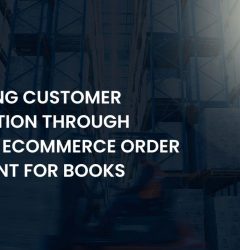04 Nov

Ever found yourself scrambling to fulfill an order because your stock ran out unexpectedly? In today’s fast-paced retail landscape, such situations can hinder customer satisfaction and profitability. Real-time inventory management offers a solution, enabling businesses to monitor, manage, and track stock levels with precision. This isn’t just a tool but a strategy crucial for long-term growth, especially for companies involved in ecommerce fulfillment services or specialized warehousing needs like pallet storage solutions in Northern Ireland. Join us as we explore the importance of real-time inventory management and its potential to transform your business.
What Is Real-Time Inventory Management?
Imagine that each product in your warehouse is instantly tracked, monitored, and updated in a system as soon as it’s moved, sold, or received. This is the power of real-time inventory management. Unlike traditional methods, which only update data at scheduled intervals, real-time systems log every transaction instantly, ensuring that stock data is always accurate and up-to-date. This real-time insight enables businesses to react swiftly to demand changes, streamline their supply chains, and enhance customer satisfaction.
With the rapid growth of e-commerce and omnichannel retailing, the need for real-time inventory management has become more pronounced. As customers expect faster deliveries and instant product availability, businesses need to match these demands with seamless stock tracking and accurate fulfillment processes. Companies offering ecommerce integration services and warehouse services for electronics find this technology especially beneficial, as it supports both high-demand and delicate inventory needs.
Why Your Business Needs Real-Time Inventory Management?
The modern retail environment requires adaptability and responsiveness. Real-time inventory management is essential in helping businesses keep pace with the constantly shifting retail landscape. Here are some compelling reasons to consider implementing a real-time inventory system:
- Prevent Stockouts and Surpluses: With real-time tracking, you’ll always be aware of stock levels, helping you prevent both understocking and overstocking. This balance is crucial in ensuring you meet demand without tying up capital in unnecessary stock.
- Enhance Customer Satisfaction: Customers expect fast, reliable service. Real-time inventory management lets you keep products in stock and delivery times short, helping you meet these expectations consistently. This level of service can be a competitive advantage for businesses handling specialized products like electronics warehousing storage solutions or pet product fulfillment & animal supplies.
- Boost Profitability: Inefficient inventory management can be costly due to shrinkage, stockouts, and overstocking. Real-time tracking reduces these risks, allowing you to streamline processes and minimize losses, directly impacting profitability.
With these benefits, real-time inventory management isn’t just an operational improvement; it’s a strategic advantage. Let’s explore the core components that power these systems and their role in boosting operational efficiency.
Core Components of Real-Time Inventory Management
To achieve real-time inventory efficiency, businesses use a combination of advanced tools and technologies that automate data collection and streamline operations. Here are the primary components that make this possible:
- RFID Technology: Radio Frequency Identification (RFID) tags are commonly used to track inventory with precision, providing up-to-the-minute updates on stock movement and location. This technology is especially valuable for industries with high turnover or specialized products, such as supplements and vitamins fulfillment or cbd order fulfillment services.
- Barcodes: Widely used across many sectors, barcodes help manage, track, and organize inventory by assigning a unique identifier to each item. This ensures smooth product flow through the supply chain, from warehouse to the end customer, making it indispensable for order accuracy and stock control.
- IoT Sensors: Internet of Things (IoT) sensors facilitate real-time monitoring, especially for temperature-sensitive or perishable products. These sensors gather data in real time and offer insight into inventory levels and conditions, which is beneficial for businesses storing products like organic foods or beauty and cosmetics items.
These technologies offer a comprehensive view of stock levels and movements, helping businesses reduce inefficiencies, prevent bottlenecks, and maintain a well-coordinated inventory flow.
5 Essential Benefits of Real-Time Inventory Management

No matter your business size, a robust real-time inventory management system is a key investment. Here’s a deeper look at the benefits it brings to operations and profitability:
1. Gain Total Control Over Your Inventory
With real-time data, businesses gain full visibility into stock levels, movement, and location, preventing costly stockouts or overstock situations. Accurate data also enables transparency with customers regarding product availability and delivery timelines. For example, companies like Meteor Space use advanced warehouse management software (WMS) that tracks SKUs from the warehouse floor to a customer’s doorstep. This accuracy helps build trust, as customers appreciate being informed about order status and delivery times.
2. Optimize Supply Chain and Workflow
Even minor inventory disruptions can cause significant delays in the supply chain. Real-time data allows businesses to identify and address these issues swiftly. For instance, if your system indicates a need for 200 units but only 150 are available, real-time alerts allow you to reorder before it becomes a problem. The result? Reduced lead times, streamlined logistics, and improved team productivity.
3. Minimize Inventory Shrinkage
In 2024, shrinkage cost U.S. retailers a staggering $94 billion, often resulting from damage, theft, or data inaccuracies. Real-time inventory management can minimize shrinkage by ensuring that all records are updated and accurate, which reduces the risk of lost profits and maintains higher customer satisfaction. This accuracy is especially important for businesses handling delicate items or high-value products, such as warehousing fulfillment service providers or those offering beauty and cosmetics fulfillment services..
4. Adapt to Demand with Flexibility
Demand in retail fluctuates, and staying prepared is essential. Real-time inventory data enables businesses to analyze past trends and forecast demand more accurately, ensuring optimal stock levels. Real-time systems can also automatically reorder stock when inventory reaches a predefined level, keeping stock control efficient and reducing waste, especially for seasonal products.
5. Improve Customer Satisfaction and Retention
Customer loyalty hinges on reliable service, and real-time inventory management ensures that you can deliver orders quickly and accurately. This capability reduces picking and packing errors, shortens lead times, and allows for prompt restocking of high-demand items. Faster, more reliable service builds customer trust and encourages repeat business, which is invaluable in today’s competitive market.
Real-Time Inventory Strategies for Effective Management
When it comes to implementing real-time inventory management, several strategies help optimize stock control and ensure operational success. Here’s a look at three popular methods:
1. Just-In-Time (JIT) Method
The JIT method enables businesses to order stock as needed, reducing holding costs and waste. While effective for steady supply chains and responsive suppliers, JIT can be vulnerable to unexpected disruptions, such as demand surges or delayed shipments. A backup supplier plan and clear demand forecasting are essential for maintaining the JIT approach, which works well for industries with predictable order cycles.
2. First-In, First-Out (FIFO) Method
The FIFO strategy is particularly beneficial for businesses handling perishable goods or products with short life cycles. This approach ensures that items received first are shipped out first, reducing waste and keeping inventory fresh. For example, Meteor Space uses responsive WMS software to help clients maintain FIFO rotation, ensuring products are always high-quality and relevant to customers’ needs.
3. Safety Stock Approach
The Safety Stock approach acts as a buffer for unexpected demand or supply chain disruptions. By calculating safety stock based on past demand and seasonality, businesses can ensure they’re prepared to meet demand at all times. Safety stock can be invaluable during peak seasons or in industries with long lead times, such as UK Fulfillment Services and Ecommerce Order Fulfillment Service providers.
Implementing Real-Time Inventory Management: Best Practices
Successfully transitioning to real-time inventory management requires a well-thought-out strategy. Here are best practices to ensure a smooth shift and optimize inventory tracking:
- Invest in Inventory Management Software: Look for software that integrates with other tools you already use, such as POS systems, e-commerce platforms, and shipping software. Solutions like NetSuite, Zoho Inventory, and Square for Retail provide scalable, customizable options tailored to small and medium-sized businesses.
- Train Your Team: Employees must be familiar with the tools and processes of real-time inventory management to maximize system benefits. Provide training sessions to help your team understand and effectively use new software, reducing errors and improving workflow.
- Continuously Monitor Data: Real-time data can reveal patterns in stock movement and demand, helping you forecast more accurately. Regularly review this data to spot trends and make adjustments to your supply chain for improved efficiency and responsiveness.
Conclusion: The Future of Real-Time Inventory Management

In a competitive retail environment, efficient inventory management is no longer optional—it’s essential. Real-time inventory management empowers businesses with data accuracy, supply chain control, and the flexibility to adapt to changing market demands. With real-time strategies and modern tools, you’re setting a foundation for sustainable growth, customer loyalty, and long-term success.
If you’re ready to enhance your inventory management, start exploring software options, train your team, and embrace the benefits of real-time insights. By making this strategic shift, you’ll transform stock control and propel your business forward in today’s ever-evolving market.
Frequently Asked Questions
Q1: How does real-time inventory management differ from periodic inventory?
Real-time inventory provides constant, up-to-the-minute stock data, while periodic systems update only at set intervals. Real-time tracking minimizes errors, maintains stock accuracy, and allows for immediate corrective action if issues arise.
Q2: Is real-time inventory management suitable for small businesses?
Yes! Small businesses can benefit immensely from real-time inventory management, especially those with complex or fluctuating inventory needs. Tools like Square for Retail and Zoho Inventory offer affordable, tailored solutions for small businesses looking to streamline inventory tracking and reduce shrinkage.
Q3: How does inventory management software support omnichannel sales?
Inventory management software synchronizes stock levels across multiple sales channels—whether online or in-store—ensuring consistent availability and preventing overselling or under-stocking. This capability is invaluable for businesses with diverse product ranges, including ecommerce fulfillment for pet supplies and beauty and cosmetics fulfillment services.
Author:
Mishal Khan
Mishal is a dedicated copywriter and content writer with experience across various niches. Currently, Mishal is focused on writing guides and other compelling blogs on warehouse management, logistics and more, crafting engaging and informative content to help businesses understand and master their supply chain. Passionate about delivering quality content, Mishal aims to make complex topics accessible and enjoyable for all readers.
UPDATED ON: 4th Nov 2024



